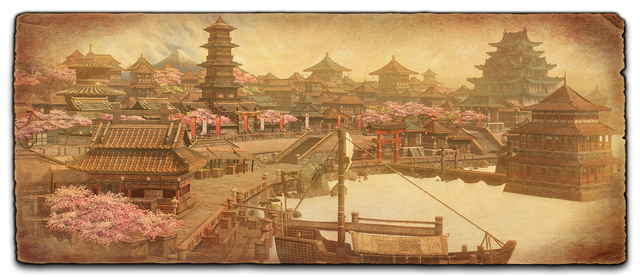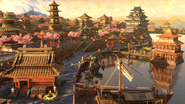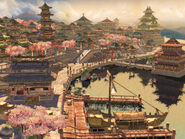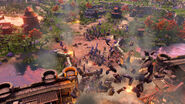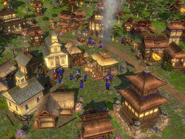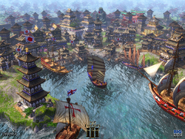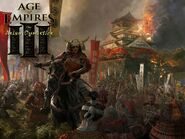| This article is about the civilization in Age of Empires III: The Asian Dynasties. For other appearances of the faction in the series, see Japanese. |
| “ | Descendants of the Yamato civilization, who inhabited the island of Japan and other parts of Asia in the far-east. The Japanese civilization is now under the Tokugawa Shogunate, that unified the country. | ” |
| —Forgotten Empires website | ||
The Japanese are one of the three playable civilizations featured in Age of Empires III: The Asian Dynasties. The civilization is based on the Edo period of Japanese history where the Tokugawa Shogunate ruled over most parts of modern Japan.
Their precursors in the series are the Yamato in Age of Empires, the Japanese in Age of Empires II, and the Japanese Age of Empires IV.
Home City[]
- Default Monk names
- Benkei, Gochin No Tajima, Honen Shonin, Ichirai Hoshi, Inei, Kosa, Rennyo, Shimotsuma Nakayuki, Shinran Shonin, Tsutsui Jomyo Meishu
 Fortress Tower (original) - The original version of the Fortress Tower (Default)
Fortress Tower (original) - The original version of the Fortress Tower (Default) Fortress Tower (red and blue) - The red and blue version of the Fortress Tower (2 points)
Fortress Tower (red and blue) - The red and blue version of the Fortress Tower (2 points) Sunset Lighting - The city with the sun setting (Default)
Sunset Lighting - The city with the sun setting (Default) Misty Morning - The city in the morning with mist (5 points)
Misty Morning - The city in the morning with mist (5 points) Night Lighting - The city at night (10 points)
Night Lighting - The city at night (10 points) Snowy Season - The city during the snowy season (10 points)
Snowy Season - The city during the snowy season (10 points)
 Imperial Court (original) - The original version of the Imperial Court (Default)
Imperial Court (original) - The original version of the Imperial Court (Default) Imperial Court (imperial gold) - The imperial gold version of the Imperial Court (2 points)
Imperial Court (imperial gold) - The imperial gold version of the Imperial Court (2 points) Snow Monkeys - Snow monkeys running loose in the city (5 points)
Snow Monkeys - Snow monkeys running loose in the city (5 points) Kamihinokinai Paper Balloon Festival - Lanterns - Lantern decorations from building to building for the Kamihinokinai Paper Balloon Festival (5 points; also requires the Night Lighting customization)
Kamihinokinai Paper Balloon Festival - Lanterns - Lantern decorations from building to building for the Kamihinokinai Paper Balloon Festival (5 points; also requires the Night Lighting customization)
 Customs House (original) - The original version of the Customs House (Default)
Customs House (original) - The original version of the Customs House (Default) Customs House (mahogany red and black) - The mahogany red and black version of the Customs House (2 points)
Customs House (mahogany red and black) - The mahogany red and black version of the Customs House (2 points) Kite Festival - The citizens of Japan celebrating the Hamamatsu Kite Festival (2 points)
Kite Festival - The citizens of Japan celebrating the Hamamatsu Kite Festival (2 points) Kamihinokinai Paper Balloon Festival - Water Lanterns - Water lanterns floating by the harbor for the Kamihinokinai Paper Balloon Festival (5 points; also requires the Kamihinokinai Paper Balloon Festival - Lanterns customization)
Kamihinokinai Paper Balloon Festival - Water Lanterns - Water lanterns floating by the harbor for the Kamihinokinai Paper Balloon Festival (5 points; also requires the Kamihinokinai Paper Balloon Festival - Lanterns customization)
Characteristics[]
Civilization bonuses[]
- Starts with 400 food, 300 wood, 100 coin, 100 export, six Villagers, and one (two if there are no Berry Bushes near the starting Town Center) Orchard Rickshaw.
- Most Home City Cards can be sent twice.
- Villagers cannot gather food from animals, have a lower train limit (75), and gather export as they gather resources.
- Build Shrines to attract nearby animals and generate a slow trickle of resources.
- Build the Consulate to ally with a European civilization or enter isolationism and get their units and technologies by spending export.
- Build Wonders to advance in Age.
[]
 Sentry: Quick-training, Pikeman who quickly loses hitpoints, becoming less effective over time.
Sentry: Quick-training, Pikeman who quickly loses hitpoints, becoming less effective over time. Irregular: Quick-training, musketeer who quickly loses hitpoints, becoming less effective over time.
Irregular: Quick-training, musketeer who quickly loses hitpoints, becoming less effective over time.
[]
 Rice Paddy: Slow, infinite source of Food or Coin. Limited to 10 gatherers.
Rice Paddy: Slow, infinite source of Food or Coin. Limited to 10 gatherers. Monastery: Trains repentant outlaws and mercenaries. Provides Monk improvements.
Monastery: Trains repentant outlaws and mercenaries. Provides Monk improvements. Castle: A powerful defensive building that can also train and upgrade artillery.
Castle: A powerful defensive building that can also train and upgrade artillery. Consulate: Spend Export here to enter into relations with European powers and gain a powerful bonus. Also use Export to purchase European troops and technologies.
Consulate: Spend Export here to enter into relations with European powers and gain a powerful bonus. Also use Export to purchase European troops and technologies.
Unique units[]
 Sohei Archer: Leader who stuns Treasure guardians and has a chance to do Divine Strike damage in combat. Explores, fights, and builds Town Centers, Trading Posts, and Shrines.
Sohei Archer: Leader who stuns Treasure guardians and has a chance to do Divine Strike damage in combat. Explores, fights, and builds Town Centers, Trading Posts, and Shrines. Villager: A Japanese villager that does not eat meat. Gathers all other resources.
Villager: A Japanese villager that does not eat meat. Gathers all other resources. Samurai: Powerful Japanese Samurai swordsman that inflicts area damage in hand combat. Good against cavalry and buildings.
Samurai: Powerful Japanese Samurai swordsman that inflicts area damage in hand combat. Good against cavalry and buildings. Ashigaru Musketeer: Japanese heavy foot soldier armed with a musket. Good against cavalry in a melee.
Ashigaru Musketeer: Japanese heavy foot soldier armed with a musket. Good against cavalry in a melee. Yumi Archer: Ranged infantry armed with the Japanese longbow. Good against infantry.
Yumi Archer: Ranged infantry armed with the Japanese longbow. Good against infantry. Naginata Rider: Heavy cavalry armed with a naginata for killing archers, skirmishers, and artillery.
Naginata Rider: Heavy cavalry armed with a naginata for killing archers, skirmishers, and artillery. Yabusame: Japanese master of the bow and the horse. Good against cavalry and artillery.
Yabusame: Japanese master of the bow and the horse. Good against cavalry and artillery. Flaming Arrow: Japanese cannon that shoots an exploding arrow. Better against infantry and artillery than buildings.
Flaming Arrow: Japanese cannon that shoots an exploding arrow. Better against infantry and artillery than buildings. Morutaru: Artillery that fires an exploding shell at buildings or ships.
Morutaru: Artillery that fires an exploding shell at buildings or ships. Daimyo Kiyomasa: Powerful Japanese lord who can train troops and receive Shipments.
Daimyo Kiyomasa: Powerful Japanese lord who can train troops and receive Shipments. Shogun Tokugawa: Supreme ruler of Japan. Can train troops and receive Shipments. Also gives nearby troops extra hitpoints.
Shogun Tokugawa: Supreme ruler of Japan. Can train troops and receive Shipments. Also gives nearby troops extra hitpoints. Yamabushi: Japanese Monk armed with a large two-handed club. Good against cavalry and buildings.
Yamabushi: Japanese Monk armed with a large two-handed club. Good against cavalry and buildings. Shinobi: Stealthy ranged infantry. Good against infantry.
Shinobi: Stealthy ranged infantry. Good against infantry. Fune: Fune. Good at exploring, fishing or transport.
Fune: Fune. Good at exploring, fishing or transport. Atakebune: Atakebune. Slow, powerful ship resistant to building fire that can train units.
Atakebune: Atakebune. Slow, powerful ship resistant to building fire that can train units. Tekkousen: Tekkousen. Heavy warship.
Tekkousen: Tekkousen. Heavy warship.
Unique buildings[]
 Shrine: Generates a tiny amount of resources. Configure it to produce different things. Attract nearby animals for bonus production. Supports 10 population.
Shrine: Generates a tiny amount of resources. Configure it to produce different things. Attract nearby animals for bonus production. Supports 10 population. Cherry Orchard: A beautiful Cherry Orchard which can be harvested for Food.
Cherry Orchard: A beautiful Cherry Orchard which can be harvested for Food. Dojo: Generates armies automatically. Configure it to produce different things. Can only be sent from the Home City.
Dojo: Generates armies automatically. Configure it to produce different things. Can only be sent from the Home City.
Wonders[]
 Golden Pavilion: Increases the attack of ranged land units, the attack of hand units, the speed of all land units, or the hitpoints of all land units. Configure it to give bonuses to different things.
Golden Pavilion: Increases the attack of ranged land units, the attack of hand units, the speed of all land units, or the hitpoints of all land units. Configure it to give bonuses to different things. Great Buddha: Casts the Informers spell which reveals the enemy's positions to you.
Great Buddha: Casts the Informers spell which reveals the enemy's positions to you. Shogunate: Decreases training time and cost of land military units.
Shogunate: Decreases training time and cost of land military units. Torii Gates: Increases the experience point build bounty for training units and constructing buildings and the bounty for defeating enemy units and buildings.
Torii Gates: Increases the experience point build bounty for training units and constructing buildings and the bounty for defeating enemy units and buildings. Toshogu Shrine: Acts as a giant Shrine and increases the amount of resources that Shrines generate. Supports 20 population.
Toshogu Shrine: Acts as a giant Shrine and increases the amount of resources that Shrines generate. Supports 20 population.
Overview[]
The Japanese are a strong civilization, but they cannot gather food via herding or hunting. They build Shrines to gain a small trickle of whatever resource they are set to, including experience, with a high-level Home City. Building Shrines around huntables or herdables will attract them to the Shrine, with each huntable or herdable animal increasing the amount of resources that the Shrine generates. The Shrines also act as Houses; they support 10 population. The Japanese may also build Cherry Orchards, which are unpacked from freely-obtained Rickshaws. As a special advantage, most cards in the Japanese Home City may be sent twice.
The Japanese have very expensive – but powerful – military units, such as the Samurai, Ashigaru Musketeers, Yumi Archers, Yabusame, Naginata Riders, as well as artillery units such as Flaming Arrows and Morutaru. The Japanese navy is average at best, but their fishing potential makes it easy to perform a water boom.
Each Asian civilization has special Monks instead of Explorers. Japanese monks, the Sohei Archers, are the only explorer-type units in the game to also be considered "archers" for the purposes of Carib Garifuna Drums' anti-Villager bonuses (x1.3 damage vs. Settlers) and other archer-specific upgrades. As with other Monks, Sohei Archers have no sniper abilities, but can stun treasure guardians. They also perform powerful "Divine Strike" attacks that instantly kill weakened enemies outright, among others. Sohei Archers can also build Shrines. If the card Mountain Warrior is sent, they will receive twice the normal resources or experience they normally would from treasures.
Changelog[]
 The Asian Dynasties[]
The Asian Dynasties[]
- The Japanese Home City cannot be customized.
 The African Royals[]
The African Royals[]
- With update 43871, the Japanese Home City can be customized.
Campaign appearances[]
| This section needs expansion. You can help by adding to it. |
The Japanese are playable in their dedicated campaign Act I: Japan in The Asian Dynasties.
In-game dialogue[]
These Japanese words or sentences spoken in this game are grammatically correct and generally standard with no particular regional dialect, but some of them are old-fashioned or pronounced with a foreign accent. The accents and styles of the language spoken by Japanese units are as follows:
- The female Villager speaks modern standardized Japanese with some non-standard (apparently foreign) accent. Each Villager job line she speaks emphasizes the third syllable of the word preceding "da ne".
- The male Villager speaks modern standardized Japanese with a standard Tokyo accent. Each Villager job line he speaks emphasizes the second syllable of the word preceding "da ne".
- The Sohei Archer speaks a kind of typically theatrical and conventional Japanese which is characterized by its old-fashioned word usage and its stylized pronunciation of words. The style of the language spoken by the monk is like that of Jidaigeki, a genre of film and television drama that depicts the life of Japan in pre-modern times. The monk sometimes speaks with the copula ja (じゃ), which, if used by a fictional character (and not as a regional dialect), usually signifies that the speaker is an old or archaic person, especially male one.
- Military units, including Daimyo and Shogun, speak a kind of theatrical Japanese characterized by its old-fashioned word usage. Some of them speak with a standard accent, while others speak with some non-standard accent.
Common[]
- 用件は? [Yōken wa?] ("What's the matter?")
- なんだ? [Nan da?] ("What?") — male villager
- 呼んだかい? [Yonda kai?] ("Did you call?") — male villager
- 何? [Nani?] ("What?") — female villager
- 呼んだ? [Yonda?] ("Did you call?") — female villager
- いいよ [Ī yo.] ("All right.")
- は [Ha.] ("Yes."; a variant of hai (はい "Yes") pronounced with a short, strong breath; old-fashioned, typically said by fictional archaic characters, especially of the feudal ages, in response to the instructions or remarks of their superior person, with an attitude of respect toward that person)
- ご命令を [Gomeirei o.] ("Your instructions?")
- 御意(に) [Gyoi (ni).] ("At your will.")
- よし [Yoshi.] ("Ok.") — male villager
- わかりました [Wakarimashita.] ("I understood")
- わかったよ [Wakatta yo.] ("I understood!") — female villager
- 行きます [Ikimasu.] ("I go.")
- はい! [Hai!] ("Yes!")
- ただいま [Tadaima.] ("At once") — fishing boat
- そうです [Sō desu.] (In this context, "I see" or "Understood") — fishing boat
- いざ [Iza.] ("Now.")
- 直ちに [Tadachi ni.] ("Immediately.")
- 仰せの通り(に) [Ōse no tōri (ni).] (Literally "As you say."; it means "In accordance with your will.")
- いざゆかん! [Iza yukan!] ("Let's go now!")
- 戦じゃ! [Ikusa ja!] ("Fight!")
- や! [Ya!] (an interjection)
Villager[]
- Female Build Tateru n da ne (建てるんだね) - "Builder", literally "To build"
- Male Build Tateru n da ne (建てるんだね) - "Builder", literally "To build"
- Female Farm Inasaku da ne (稲作だね) - "Rice cultivator", literally "Rice cultivation"
- Male Farm Inasaku da ne (稲作だね) - "Rice cultivator", literally "Rice cultivation"
- Female Gather Coin Otakara da ne (お宝だね) - "Miner", literally "(To gather) treasure"
- Male Gather Coin Otakara da ne (お宝だね) - "Miner", literally "(To gather) treasure"
- Female Gather Fruit Shokuryō da ne (食料だね) - "Forager", literally "(To gather) food"
- Male Gather Fruit Shokuryō da ne (食料だね) - "Forager", literally "(To gather) food"
- Female Gather Meat Kari da ne (狩りだね) - "Hunter", literally "To hunt"
- Male Gather Meat Kari da ne (狩りだね) - "Hunter", literally "To hunt"
- Female Gather Wood Mokuzai da ne (木材だね) - "Woodcutter", literally "(To gather) wood"
- Male Gather Wood Mokuzai da ne (木材だね) - "Woodcutter", literally "(To gather) wood"
- Female Repair (not used in the game) Naoshimashō (直しましょう) - "Repair", literally "(I'll) repair (it)"
- Male Repair (not used in the game) Naoshimashō (直しましょう) - "Repair", literally "(I'll) repair (it)"
Monk[]
- Select 1 Nan ja na? (なんじゃな?) - Literally "What is it?", responding in a mild tone (na) to some action or situation; "What's the matter?"
- Select 2 Yō ka na? (用かな?) - Do you have a business with me?
- Select 3 Nan nari to (なんなりと) - Literally "In whatever way", here it means like "Order me whatever you'd like"
- Move 1 Hm…
- Move 2 Shōchi shita (承知した) - I understand
- Move 3 Sochira e yukō. (そちらへ行こう) - I'll go there (The particle 'e' へ is pronounced 'ye' as it mostly was in the Edo period.)
- Attack 1 Kōgeki ja! (攻撃じゃ!) - Attack!
- Disabled Omukae ga kita yō ja (お迎えが来たようじゃ) - Literally "The welcoming seems to have come"; reflecting a belief widely shared among Japanese Buddhists, especially Jōdo-related ones, this conventional phrase traditionally refers to the coming of Amida Buddha in front of a dying person to welcome that person into the land where Buddha lives, that is, Jōdo or "Pure Land".
- Revived Hotoke-sama no go kago no okage ja. (仏様のご加護のお陰じゃ) - It's thanks to Buddha's protection
Japanese version[]
Ready[]
- Civilian
- Nan da? なんだ? (male Villager)
- Nani? 何?) (female Villager)
- Yonda? - (呼んだ?)
- n? - (ん?)
- 'Hai - (はい?)
- Military
- Nan nari to - (なんなりと)
- Gomeirei wo. - (ご命令を)
- Ha. - (は)
- Monk
- Nan nari to - (なんなりと)
- Yō ka na? - (用かな?)
- Nan ja na? - (なんじゃな?)
- Daimyo
- Umu - (うむ)
- Nan ja? - (なんじゃ?)
Moving[]
- Civilian
- Ikuyo. - (行くよ)
- Ikimasu. - (行きます) (female Villager)
- Wakadda. - (わかっだ)
- Shouchi - (承知)
- Military
- Tadachi ni. - (直ちに)
- Shouchi - (承知)
- Iza - (いざ)
- Monk
- Umu - (うむ)
- Shōchi shita - (承知した)
- Ikimashyou. - (行きましょう)
- Military
- Yukou - (行こう)
- Shouchi - (承知)
- Iza - (いざ)
Attack[]
- Common
- Kagare! - (かがれ)
- Yaa! - (やぁ)
- Taa! - (たぁ)
- Artillery
- Utte! - (撃って!)
- Picking resources
- Female Build Tateru no ne (建てるのね) - "Builder", literally "To build"
- Male Farm Kome da ne (米だね) - "Rice cultivator", literally "Rice cultivation"
- Female Farm Kome ne (米ね) - "Rice cultivator", literally "Rice cultivation"
History[]
| “ | The Sengoku, or Warring States period, lasted roughly from 1478 to 1605 and was a time of tremendous social upheaval and political strife in Japan, defined by an almost endless state of war. The centralized government of the reigning Ashikaga shogunate had begun to lose the loyalty of many daimyo, or feudal lords, across Japan. Individual provinces were beginning to turn inwards and busy themselves with local matters. This was especially true of those domains far from Kyoto, the center of power. Many factors contributed to the gradual fragmentation of the shogunate. Trade with China was growing rapidly, developing the Japanese economy and boosting the importance of money to local economies. Commercial cities began to appear across the countryside, and a great desire for local autonomy developed, touching all classes of the social hierarchy. Soon, frustrated over rising taxes and the damage done by famines and earthquakes, peasants began to revolt. As chaos began to take hold of the rural villages, unrest broke out in Kyoto, where a dispute over shogunal succession triggered the Onin War (1467–1477). The Hosokawa family and its allies clashed with the Yamana family over the right to wield Japan's cetral authority. This conflict raged for 11 years, further weakening the role of the shogunate, and it eventually spread out to the waiting powder keg that had become the surrounding provinces. Regional daimyo suddenly rose up to take control where the central authority had none. During this time, notable clans such as the Takeda and the Imagawa were able to greatly expand their spheres of influence. This was not true of all local lords, however, as many were overtaken by their own subordinates and replaced. This was known as gekokujo, literally translated to mean "the underling conquers the overlord." A century passed and the feudal warring continued, even as a possibility for peace grew on the horizon. Oda Nobunaga, who had emerged from obscurity to seize power over much of central Japan, seemed poised to unite the scrabbling clans into an alliance; but before he could, Nobunaga fell victim to the treachery of one of his own generals in 1582. This left the path to power open for whoever had the ambitions to take it. One of Nobunaga's most trusted underlings, a general and former foot soldier named Toyotomi Hideyoshi, stepped in where his predecessor had left off and continued the work to unify the feuding families. Hideyoshi could never become a true shogun as he was of common birth, but he did consolidate enough power to be named an Imperial Regent by the Emperor of Japan. After several ill-fated invasions of Korea, Hideyoshi died in 1598 without leaving a capable successor to his dynasty. Again, the nation teetered precariously on the edge of chaos. It was then that the powerful daimyo of Mikawa province, Tokugawa Ieyasu, chose to make his move, one he had been planning for years. | ” |
Trivia[]
- The only in-game way to listen to the Japanese dialogue for "Hunter" [Kari da ne.] is to obtain a European Settler, either by rescuing from Treasures or researching the Sequoyah's Cherokee Syllabary technology.
- The Japanese flag shown in the game features the emblem (mon) of the Tokugawa shogunate (1603–1867) on a black background.
- According to early screenshots before the release of The Asian Dynasties, the Japanese flag in the game would be the Civil and state flag and ensign of the Empire of Japan used by the Japanese Empire between 1870–1999.

